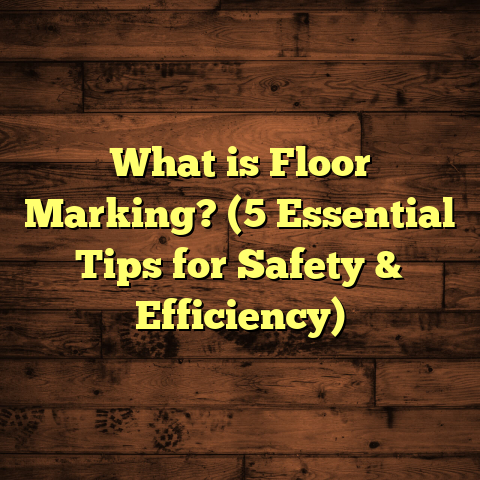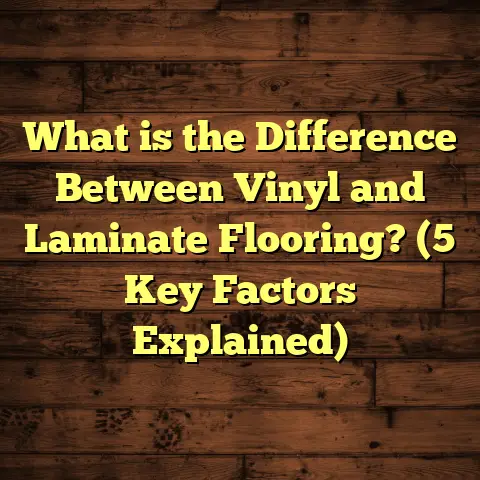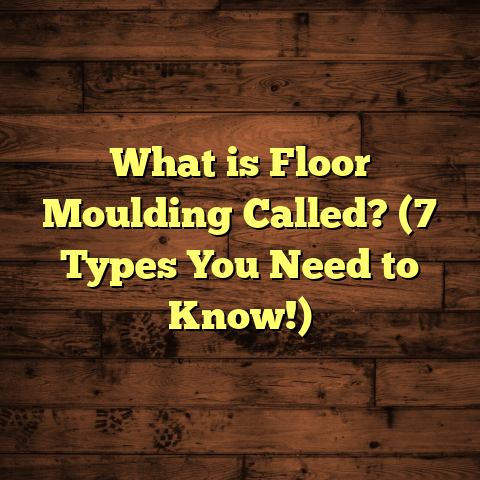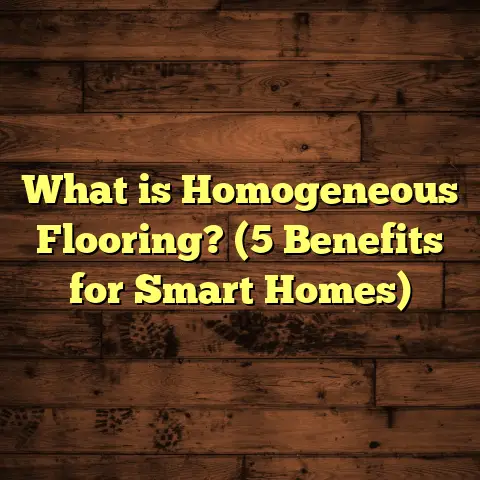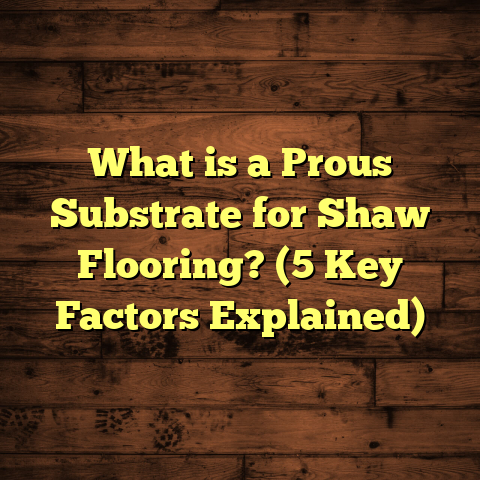What is More Expensive: Carpet or Vinyl Flooring? (5 Key Factors)
I once stood in a client’s living room, staring at two huge samples laid out side by side: plush carpet in a calming beige tone, and sleek vinyl planks with a modern wood-look finish. The question was clear but tricky: which flooring choice would cost more in the long run? This dilemma is something I encounter often as a flooring contractor. It’s rarely just about the sticker price. There are layers to the story—material quality, installation complexity, maintenance needs, comfort, and even resale impact.
If you’re wondering what is more expensive: carpet or vinyl flooring, let me walk you through five key factors that will help you make an informed decision. I’ll share some stories from my years on the job, data I’ve gathered from multiple projects, and practical advice you can use whether you’re tackling a DIY renovation or hiring pros.
What is Carpet and Vinyl Flooring?
Before we break down costs and factors, it helps to understand what carpet and vinyl flooring really are. This gives context for why prices vary so much.
Carpet Flooring
Carpet is a textile floor covering made from woven or tufted fibers. These fibers can be natural (like wool) or synthetic (nylon, polyester, olefin). Carpets come in many styles—plush, Berber, frieze—and pile heights (the length of the fibers).
Carpet is known for its:
- Softness and warmth underfoot
- Sound absorption qualities
- Variety of colors and textures
Because it is textile-based, carpet offers a cozy feel that’s especially popular in bedrooms and family rooms.
Vinyl Flooring
Vinyl flooring is a manufactured product made from synthetic polyvinyl chloride (PVC). It comes in sheets, tiles, or planks. Thanks to advances in printing and embossing technology, vinyl can mimic the look of hardwood, stone, or ceramic tile quite well.
Vinyl is prized for:
- Water resistance and durability
- Easy cleaning
- Versatile design options
It’s often used in kitchens, bathrooms, basements, or other areas prone to moisture.
1. Material Costs: Breaking Down the Price Tags
Understanding material costs sets the foundation for comparing total expenses. Let’s look closer.
Carpet Material Pricing
When clients first ask about carpet prices, they usually expect a simple answer. But carpet costs vary widely based on fiber type, construction method, brand, and quality.
For example:
| Carpet Type | Price per Sq Ft (Material Only) | Typical Use Cases |
|---|---|---|
| Polyester | $1.50 – $3.50 | Budget-friendly homes |
| Nylon | $3 – $6 | Durable residential use |
| Wool (Natural) | $7 – $15+ | Luxury installations |
Synthetic carpets like nylon are popular because they balance cost and durability well. In my experience, nylon carpets tend to resist stains better than polyester but cost a bit more.
Wool carpets are rare in average homes due to their price but offer unmatched softness and natural insulation. I installed wool carpet recently in a high-end client’s library; it was stunning but set them back over $12 per square foot just for material.
Padding is another factor. Quality carpet padding adds $0.50-$1 per square foot but significantly impacts comfort and carpet life.
Vinyl Material Pricing
Vinyl flooring also spans a broad price range depending on type:
| Vinyl Type | Price per Sq Ft (Material Only) | Typical Use Cases |
|---|---|---|
| Sheet Vinyl | $1 – $3 | Budget kitchens, laundry |
| Luxury Vinyl Tile (LVT) | $2 – $7 | Residential & commercial |
| Luxury Vinyl Plank (LVP) | $3 – $8 | Wood-look designer floors |
Luxury vinyl planks have become very popular due to their realistic wood appearance and waterproof nature. In one project I managed recently, LVP material cost was around $5 per square foot for mid-range branded products.
Sheet vinyl remains the cheapest option but can look less natural and may not hold up as well over time if installed in heavy-traffic areas.
Comparing Material Costs
If you’re budgeting purely by material price alone:
- Basic carpet with padding often totals around $3-$6 per square foot.
- Mid-range luxury vinyl plank materials typically run $4-$7 per square foot.
- Premium options on both sides can push prices higher.
My advice? Don’t choose solely on material price without considering installation and maintenance costs next.
2. Installation Costs: Labor Impact on Total Expense
Material cost is just one part of the equation. Installation labor and prep can add significantly to your budget.
Carpet Installation Details
Carpet installation isn’t simply rolling out the fiber. It involves:
- Removing old flooring
- Prepping the subfloor
- Laying down padding
- Cutting carpet to fit room dimensions
- Stretching and securing edges with tack strips
This process usually costs $1.50 to $3 per square foot for labor alone depending on complexities like stairs or irregular room shapes.
I remember one job where a client wanted wall-to-wall carpet installed over an uneven concrete slab. We had to spend extra time leveling the subfloor before padding. That added nearly $0.75 per square foot to labor costs beyond standard pricing.
Vinyl Installation Details
Vinyl installation costs vary by type:
- Sheet vinyl is usually glued down or loose-laid; installation runs about $1.50 to $3 per sq ft.
- Luxury vinyl plank (LVP) flooring requires precise fitting with locking mechanisms; this can increase labor costs to $2 to $5 per sq ft.
- Glue-down LVP installations are more involved, sometimes pushing labor up to $6 per square foot due to adhesive drying times and surface preparation.
In one project covering 1,200 sq ft of LVP in an open concept area with multiple cuts around kitchen islands and cabinets, labor took longer than expected because of intricate layout requirements. The client ended up paying about $3.75 per square foot for installation.
Additional Installation Factors
- Removing old flooring adds labor costs.
- Furniture moving or heavy debris disposal may be extra.
- Subfloor repairs or moisture barriers can increase expenses.
- Stairs or other difficult areas typically come with surcharges.
My Experience with Installation Costs
When clients ask me which is cheaper overall for installation: carpet or vinyl, I usually say it depends on your project specifics.
For example:
- Simple rectangular rooms with wall-to-wall carpet tend to have lower labor costs than custom-cut LVP installations.
- Bathrooms or kitchens needing waterproof vinyl might require special prep work adding cost.
- Padding under carpet adds comfort but also adds upfront expense.
3. Durability & Maintenance: What You’ll Spend Over Time
Here’s where many people underestimate the true cost of their flooring choice: upkeep and lifespan.
Carpet Durability & Maintenance
Carpet fibers wear down over time due to foot traffic, sunlight exposure, spills, and pets. Even the best nylon carpets generally last 8-12 years in living rooms or hallways before showing visible wear.
Regular maintenance includes:
- Daily or weekly vacuuming
- Periodic deep steam cleaning every 12–18 months
- Spot treatments for stains
Professional steam cleaning costs about $200-$300 for an average house (2,000 sq ft). Over 10 years, you might spend approximately $1,000-$1,500 just maintaining carpet appearance.
I remember a client who had wall-to-wall nylon carpet installed ten years ago. They ignored professional cleaning for years until it looked dingy and stained beyond repair. Replacing that carpet cost them nearly $7,000 including new padding and installation—much more than routine maintenance would have been.
Vinyl Durability & Maintenance
Vinyl floors are known for their resilience:
- Water-resistant or waterproof depending on type
- Resistant to most stains and scratches
- Easy cleanup with mop and mild detergent
LVP can last 15-25 years with proper care; sheet vinyl slightly less but still durable if installed well.
Maintenance is minimal compared to carpet:
- Regular sweeping or vacuuming
- Damp mopping occasionally
- Avoid abrasive cleaners or waxes
If damage occurs (e.g., gouges or tears), replacing individual planks or tiles can be costly and tricky.
From my experience working on rental units with vinyl floors installed over a decade ago, many still look great with minimal upkeep—saving landlords significant maintenance costs compared to carpet replacements every few years.
Cost Comparison Over 10-20 Years
To put it bluntly:
| Flooring Type | Average Lifespan | Maintenance Cost (10 Years) | Replacement Frequency | Notes |
|---|---|---|---|---|
| Carpet (Nylon) | 8 – 12 years | $1,000 – $1,500 | Every 10 years | Stains/damage common |
| Wool Carpet | 10 – 15 years | $1,500+ | Every 12+ years | Expensive upfront & upkeep |
| Luxury Vinyl Plank | 15 – 25 years | $100 – $300 | Every 20+ years | Minimal maintenance |
| Sheet Vinyl | 10 – 20 years | $100 – $300 | Every 15+ years | Easier replacement if damaged |
4. Aesthetic & Comfort: How Much Are You Willing to Pay?
Choosing flooring isn’t just about dollars—it’s about how it feels and looks day-to-day.
Comfort Factor: Carpet Wins Hands Down
If you’ve ever walked barefoot on plush carpet after a long day, you know what I mean. Carpet offers softness underfoot and warmth that vinyl simply can’t replicate without additional underlayments.
Many clients with young kids or elderly family members prefer carpet for its cushioning effect which reduces slips and falls injuries.
One elderly client told me their wall-to-wall carpet made winter mornings bearable because the cold hardwood floors were replaced by something cozy underfoot.
Aesthetic Choices: Vinyl’s Design Flexibility
Vinyl has come a long way visually. High-quality LVP has realistic wood grain textures that many guests don’t realize aren’t real hardwood at first glance.
Vinyl also offers:
- Stone-look tiles
- Ceramic tile patterns
- Wide range of colors and finishes
For areas like kitchens or bathrooms where moisture is a concern, vinyl allows homeowners to have the style of wood or stone without worry about water damage.
I installed luxury vinyl plank in a client’s basement rec room recently. They loved how it brightened the space compared to dark carpet while being easy to clean after kids’ crafts or sports gear messes.
Impact on Room Acoustics
Carpet absorbs sound much better than vinyl—important if you live in multi-story homes or apartments wanting less echo and noise transmission.
Vinyl tends to reflect sound more unless special soundproof underlayments are added—which increases cost again.
5. Resale Value & Market Trends: What Buyers Want
When clients are remodeling to sell their homes, resale value becomes key.
How Flooring Choice Affects Resale Price
According to multiple real estate market studies:
- Homes with hardwood floors or high-quality luxury vinyl floors tend to have higher resale values than those with older carpets.
- Buyers associate hardwood or wood-look floors with cleanliness and modern style.
- Carpet can deter buyers if worn or stained but new plush carpets still appeal in bedrooms in cooler climates.
In colder regions where warmth is a priority, soft carpets in bedrooms may be a selling point for families.
Case Study: Renovation Impact on Sale Price
I worked on a house flip where the owner replaced dated floral carpet in living areas with luxury vinyl plank flooring before listing. The home sold within two weeks for 5% higher than similar comps nearby still featuring old carpets.
Another homeowner chose plush wall-to-wall carpet for bedrooms while installing vinyl in kitchens and bathrooms. The combination was praised by buyers for comfort plus practicality—and the house sold near asking price after only 10 days on market.
Additional Thoughts: Hidden Costs & Budgeting Tips
There are some extra expenses many people overlook when comparing carpet vs vinyl:
Disposal Fees
Removing old carpet often requires special disposal due to padding materials—sometimes costing $200-$400 extra depending on local waste rules.
Vinyl removal can be easier but glue-down sheets may require scraping that adds labor time.
Subfloor Preparation
Leveling uneven surfaces or installing moisture barriers under vinyl floors adds cost but pays off in floor longevity.
Carpet tolerates minor unevenness better but still needs smooth subfloors for proper installation.
Warranty Considerations
Many manufacturers offer warranties covering materials and sometimes installation defects:
- Carpet warranties range from 5 to 15 years depending on brand.
- Vinyl warranties can extend up to 25 years for residential products.
Reading warranty details carefully can save money if defects appear early.
Final Thoughts From My Experience
After installing hundreds of thousands of square feet of both carpet and vinyl over my career, here’s what I tell clients facing this choice:
If upfront budget is tight, sheet vinyl might be your best option—but be ready for tradeoffs in comfort and possibly appearance.
If you want durability with low maintenance, luxury vinyl plank wins hands down despite higher initial costs—it pays off over decades.
If comfort and warmth matter most, especially in bedrooms or living rooms, don’t discount carpet—just plan for more upkeep over time.
For resale-focused projects, consider mixing both: durable vinyl in wet areas/kitchens and fresh carpet in bedrooms for warmth appeal.
Using tools like FloorTally helps me provide clients accurate estimates tailored by location, labor rates, waste factors, material preferences—making budgeting easier before committing.
If you want me to help you estimate your exact project cost based on your home size and choices—or share detailed advice based on your lifestyle—just ask! Flooring isn’t one-size-fits-all; it’s about finding what fits you best financially and functionally over years of living there.
Would you like me to create a detailed sample cost breakdown using FloorTally estimates for common room sizes? Or share more personal stories from tricky installs I’ve tackled? Just let me know how I can assist your flooring journey!
